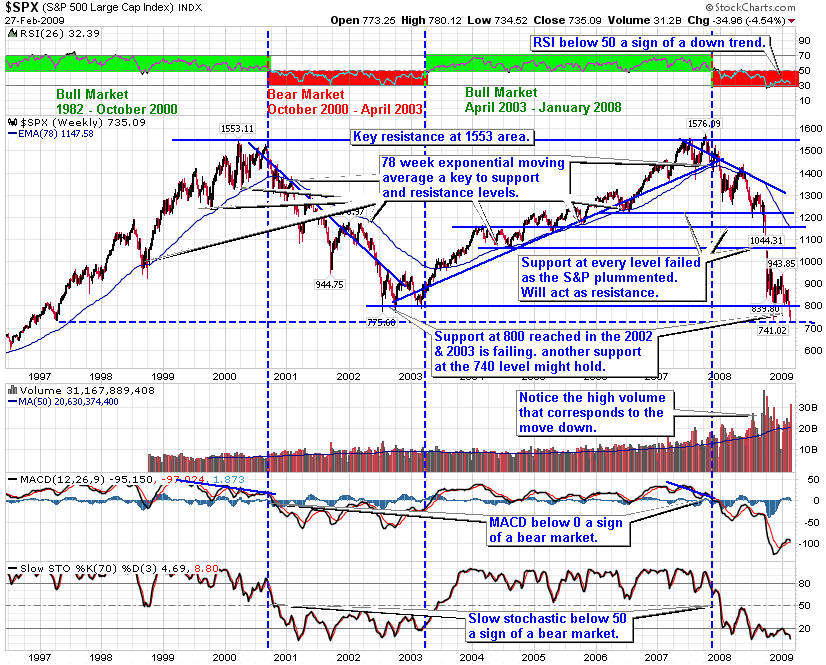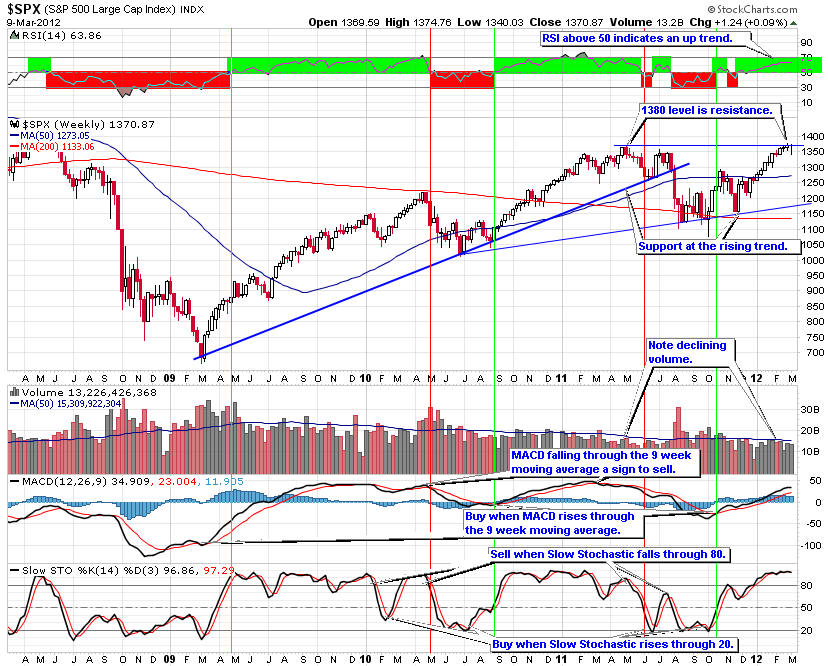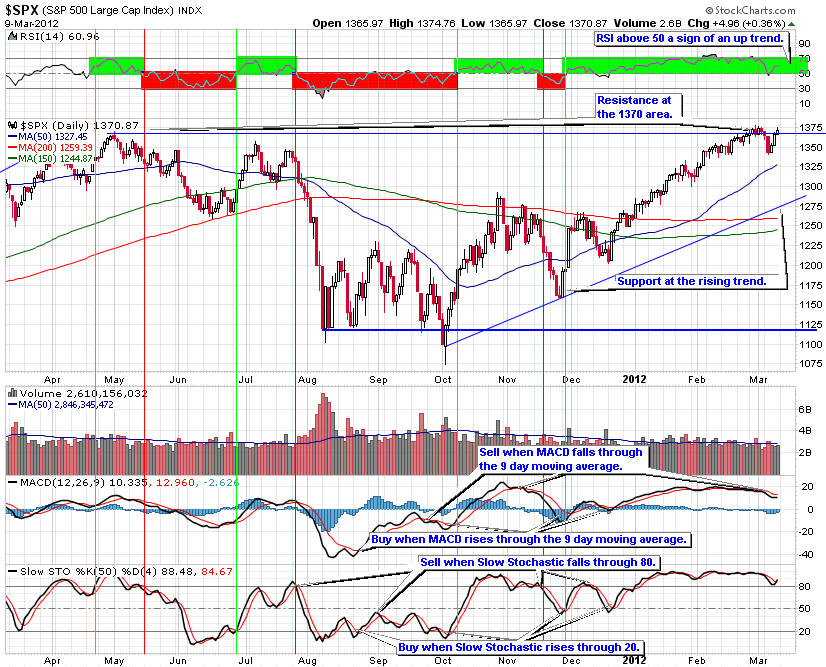

This is a free monthly newsletter on stock market trends to help you to learn to invest. Following the trend is a proven way to beat the market and grow your stock portfolio. Basic technical analysis provides the tools to identify and follow the trends of the market as determined by the S&P 500.
It is best to begin with the big picture in mind and then work our way down to weekly and then daily views of the charts. You will notice that the chart and the value of the indicators change as we move from a monthly to a weekly and then a daily chart. This is a normal part of the technical analysis.
Let's start with the long term view of the S&P 500. The Relative Strength Index (RSI) is a good indicator of the cyclical bull and bear markets. In addition, the 78 week Exponential Moving Average (EMA) acts as support in a bull market and resistance in a bear market.
In January we fell into a bear market as the RSI dropped below 50. The index fell through the rising trend line and the 78 week exponential moving average and MACD crossed below zero. This is consistent with the fundamentals of a weakening economy, and a recession. It is best to remain nimble during times like this.
The S&P 500 has fallen for three straight months reaching the lows of 2002 - 2003, the last bear market. This does not mean the current bear market is over. rather we might see a rally for several weeks to months and then a retest of the lows.
The MACD is trending down, though it is at a low point where it normally turns up. The Slow Stochastic remains below 20.
The 78 week exponential moving average and the bear market down trend remain as key resistance for the bear market.

The weekly S&P 500 shows more closely the transition from a bull to a bear market. So far the descending trend line and the 50 week moving average are the primary resistance for this bear market.
Support at 1230 and 1170 failed and the market, indicating further weakness. The index is now creating new three year lows and could be forming a flag pattern, a bullish formation. If so, then we might see a rally in the near future.
RSI below 50 indicates a down trend. MACD is at a low point and is poised to turn up. When it rises through the 9 week moving average we will have a buy sign. Slow Stochastic rose through 20 and then fell back. When it once again rises through 20, it will be an early buy sign.
Long term the trend is still down, but we are likely to see consolidation at this level and possibly a rally up to 1,000 and maybe even resistance at the 1200 area.

In the daily S&P 500 chart below a horizontal channel is forming with support at 850 and resistance at 1,000. This is a good sign that the market is forming a base from which it can rally. However, it can also fall further.
RSI is below 50 indicating a down trend, though it is close to breaking up through 50. The MACD rose up through the nine day moving average, a buy sign. Further we now see positive divergence on the MACD, which is another good indicator of a rally. The Slow Stochastic signaled a buy when it moved up through 20 once again. The indicators are giving a buy sign, indicating a rally is most likely.
Look for a break through the 1,000 level as a sign the market will go higher. If that happens it would indicate a year end rally is underway.
Should we get a move up, look for resistance at the lower descending trend line and the 50 simple moving average. If the rally pushes through these levels then significant resistance will be encountered at the 200 simple and exponential moving averages, and the upper descending trend line.
In bear markets it is best to be nimble and/or use risk protection such as trailing stops, protective put options and even covered call options. On a sign the market is unable to penetrate resistance, you might consider using the short and ultra short ETFs.

Given this perspective, it is important to have your portfolio positioned for a short term rally and a long term bear market. This means investors should assess their long positions to see if they are ready for a multi week to multi month rally. Then once the rally is over, they need to be ready to short the market as we will likely see a test of the recent lows.
When the market falls during a bear market you should either be in cash or be short. The short and ultra short ETFs are good ways to short the market without having to depend on selecting specific stocks.
While it is tempting to buy when the market falls, it is a better strategy to be sure the market has formed a base. Most likely the prices of many companies will be even lower. That doesn't mean you cannot buy high quality companies that are in sectors that are trending up. Just keep in mind, Warren Buffett's first rule of investing is to not loose money. Patience is key when markets are moving down.
Try the free four week subscription to our Premium Members pages and receive:
If you decide to continue at the end of the four-week trial your subscription starts automatically. If you decide to cancel before the end of the trial, you will not be charged a thing.
Give the Premium Membership a try. You have nothing to lose and a lot to gain and we have beat the market every year since our inception.